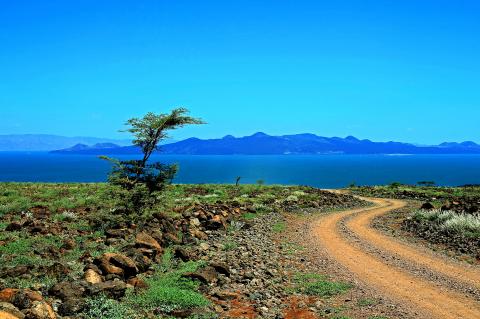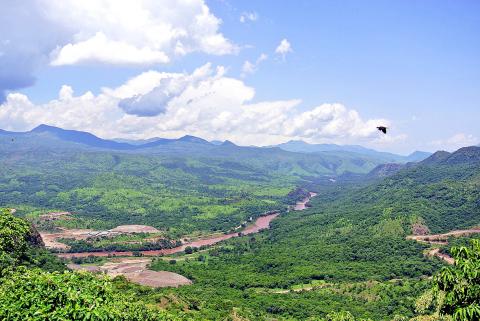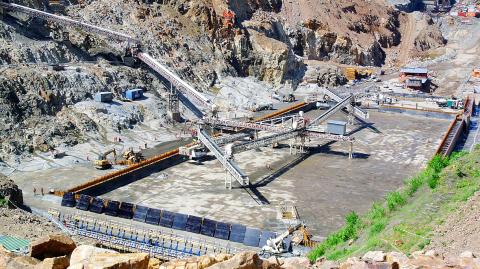The mud-colored Omo River, which snakes through green gorges, feeding lush vegetation and providing vital water to one of Ethiopia’s most remote regions, will also power a contentious dam project.
The Ethiopian government says the Gibe III dam will boost development, give access to power for many Ethiopians — about half of the population — currently living without it and generate revenue from the export of electricity to the region. However, with construction under way for Africa’s highest dam at 243m, critics say Ethiopia must also consider the environmental and social impact it will have on about 500,000 people living downstream and at Lake Turkana in neighboring Kenya. Their livelihoods rely on the river.
“If they’re going to build this huge hydropower dam than it should be done in a way that benefits the people who are most affected,” said David Turton, a senior research fellow at Oxford University’s African Studies Centre.

Photo: AFP
The Omo River is more than 700km long and supplies Lake Turkana with 80 percent of its water. It is a source of annual flooding for the agro-pastoralists living in the Lower Valley of the Omo, a UNESCO World Heritage Site.
The completion of the dam in 2014, which will have a capacity of 1,870 megawatts, will regulate the river’s flow and, according to the Ethiopian Electric Power Corp (EEPCo), offer a predictable water source for communities living along the river south of the dam.
Agro-pastoralists in Omo’s valley have traditionally relied on flood-retreat agriculture for cultivation and animal grazing.

Photo: AFP
“Before, the wet season was two months, or maximum three months, then there was nine months of drought, now for 12 months there will be a regulated flow for all the downstream users,” EEPCo chief executive Mirhet Debebe said.
The centuries-old flood-retreat agriculture practiced by the downstream tribes is a cultural mainstay of the Bodi, Mursi and Nyangatom tribes.
However, Azeb Aznake, Gibe III project manager at EEPCo, has said artificial flooding would be created annually “so that their practice is not interrupted.”

Photo: AFP
She said the regular river flow would provide irrigation for small-scale cultivators downstream and denied that the Gibe III dam would feed irrigation channels to nearby foreign-owned plantations, as some groups have charged.
“The purpose of the dam is for hydroelectric power, and nothing more,” Azeb said.
Most of the US$1.8 billion cost of the project — the third in a series of five dams planned along the Omo River — will be covered by EEPCo, with a Chinese firm bankrolling the US$400 million electromechanical costs.
The dam has been mired in controversy from the project’s inception and the “Stop Gibe 3” online petition has collected more than 18,000 signatures. Azeb admitted that any project of this magnitude is bound to have an impact on local communities and ecosystems, but said the overall benefits were too great to ignore.
“Water is our major resource ... We have to make use of it and develop, we have to eat three times a day like any human being, so there has to be compromise,” she said.
For Frederic Mousseau, policy director at the US-based think tank Oakland Institute, which is opposed to the dam’s construction, the benefits are not widespread enough.
“It’s really about who benefits and what benefits ... At the macro level you might have increased exports, economic growth, but what about human development, what happens to the people?” he said in a telephone interview.
He urged the Ethiopian government to halt the dam’s construction “so investment could go towards infrastructure that could really benefit the people.”
Some nearby residents welcome the job opportunities that have accompanied the dam’s constructions. Over 4,000 Ethiopians have been hired to help build Gibe III, which was started in 2006 and is over 50 percent complete.
“It is good for our development and the area’s development [because] we get more employment,” said Mengistu Mara, 26, a student in Lala town about 30km away from Gibe III.
His brother who works as a crane operator at the dam pays Mengistu’s school fees at the local high school, built in 2009 by the dam’s contractors.
“I’m learning now because my brother is bringing me money,” he said, standing in front of the school built near the village’s newly paved road.
Lala resident Desalegn Barata, 41, also welcomed the job creation, but said that even with the construction site next door, his community still has no clinic.
“There is no clinic or hospital and there are many diseases here,” he said, swatting at the flies swarming around him in the midday heat.
For Turton, the government should prioritize social justice as the project moves ahead, saying it is possible to balance the benefits with the potential impact.

Taiwan Semiconductor Manufacturing Co (TSMC, 台積電) last week recorded an increase in the number of shareholders to the highest in almost eight months, despite its share price falling 3.38 percent from the previous week, Taiwan Stock Exchange data released on Saturday showed. As of Friday, TSMC had 1.88 million shareholders, the most since the week of April 25 and an increase of 31,870 from the previous week, the data showed. The number of shareholders jumped despite a drop of NT$50 (US$1.59), or 3.38 percent, in TSMC’s share price from a week earlier to NT$1,430, as investors took profits from their earlier gains

In a high-security Shenzhen laboratory, Chinese scientists have built what Washington has spent years trying to prevent: a prototype of a machine capable of producing the cutting-edge semiconductor chips that power artificial intelligence (AI), smartphones and weapons central to Western military dominance, Reuters has learned. Completed early this year and undergoing testing, the prototype fills nearly an entire factory floor. It was built by a team of former engineers from Dutch semiconductor giant ASML who reverse-engineered the company’s extreme ultraviolet lithography (EUV) machines, according to two people with knowledge of the project. EUV machines sit at the heart of a technological Cold

Taiwan’s long-term economic competitiveness will hinge not only on national champions like Taiwan Semiconductor Manufacturing Co. (TSMC, 台積電) but also on the widespread adoption of artificial intelligence (AI) and other emerging technologies, a US-based scholar has said. At a lecture in Taipei on Tuesday, Jeffrey Ding, assistant professor of political science at the George Washington University and author of "Technology and the Rise of Great Powers," argued that historical experience shows that general-purpose technologies (GPTs) — such as electricity, computers and now AI — shape long-term economic advantages through their diffusion across the broader economy. "What really matters is not who pioneers

TAIWAN VALUE CHAIN: Foxtron is to fully own Luxgen following the transaction and it plans to launch a new electric model, the Foxtron Bria, in Taiwan next year Yulon Motor Co (裕隆汽車) yesterday said that its board of directors approved the disposal of its electric vehicle (EV) unit, Luxgen Motor Co (納智捷汽車), to Foxtron Vehicle Technologies Co (鴻華先進) for NT$787.6 million (US$24.98 million). Foxtron, a half-half joint venture between Yulon affiliate Hua-Chuang Automobile Information Technical Center Co (華創車電) and Hon Hai Precision Industry Co (鴻海精密), expects to wrap up the deal in the first quarter of next year. Foxtron would fully own Luxgen following the transaction, including five car distributing companies, outlets and all employees. The deal is subject to the approval of the Fair Trade Commission, Foxtron said. “Foxtron will be